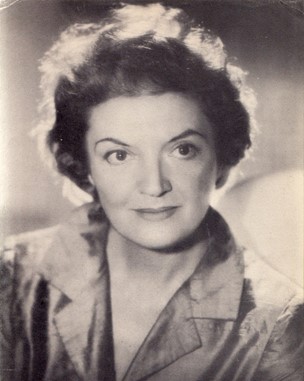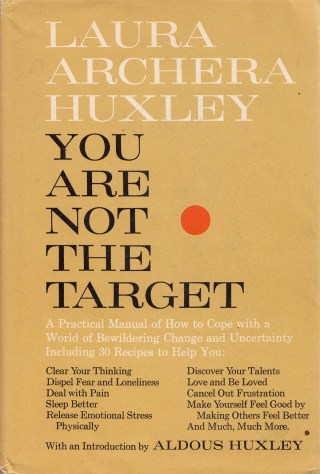- “Please Write Up Your Work!”: Laura Archera Huxley as a Psychedelic Pioneer - December 2, 2020
- Another Aspect of Reality: Maria Nys Huxley’s Influence on Psychedelic History - November 25, 2020

“If a person doesn’t do something either useful or beautiful, then one doesn’t have any right to take the oxygen of people and the food of people.” These words were spoken by Laura Archera Huxley, lay therapist, researcher, and second wife of British intellectual and novelist, Aldous Huxley. She said this during a 1988 “Pioneers in Research Series” interview recorded as part of the Institute for Noetic Sciences’ Gathering of the Elders conference. This brief quote speaks volumes about Laura’s hardworking, ambitious character, as well as her broader perspectives on life, labor, community, and happiness: all crucial concepts related to her decades-long interest in psychedelic therapies.
“If a person doesn’t do something either useful or beautiful, then one doesn’t have any right to take the oxygen of people and the food of people.”
Laura Archera Huxley
Yet, despite her inclusion in a series on psychedelic pioneers, Laura is rarely credited with this status in studies of American psychedelic culture. It seems there is real truth in historian Mike Jay’s observation that the public faces of psychedelics have typically belonged to college-aged white men, and that limiting our understanding of drug users and researchers to this narrow group hides the important role of women like Laura within these historical spaces.

Laura Archera Huxley
Laura was born in Turin, Italy in 1911. In her youth, she was a prodigious concert violinist; she had even once played for the queen of Italy, Marie José of Belgium, before debuting at Carnegie Hall in 1937 with the New York Women’s Symphony Orchestra. Laura moved to the United States shortly before her New York performance. When World War II began, she decided to quit music to instead learn about psychology and alternative medicine. Laura’s interest in film eventually led her to Los Angeles, where she first met Aldous and then-wife Maria in 1949. The three became close friends, but Aldous and Laura’s relationship became a romance after Maria passed away from cancer in 1955. They spontaneously married the following year at a drive-in wedding chapel in Yuma, Arizona.
Defying Expectations
Laura defied expectations of what it meant to be a proper wife right from her wedding day. Friends of the Huxley family initially assumed Aldous’ new wife would assume the same sort of caretaking responsibilities Maria had previously shouldered for Aldous’ benefit; after all, postwar American women were generally expected to dote on their husbands inside of the home instead of pursuing their own careers and interests outside of it. That Laura refused to play the role of Aldous’ caretaker shocked some of her husband’s peers, and several of them made comparisons between her and Maria as a result.
For example, in 1957, the Huxleys’ longtime friend Dr. Humphry Osmond privately described Laura as “very much like a large and self-contained cat in human form: decorative and Aldous likes having her around. She does not devote herself to Aldous as Maria did, but this may perhaps be just as well. If anything she errs in the other direction.” Laura, it seems, rejected the idea that she should limit herself to simply being Aldous’ housewife despite what others thought.
Sign up for our newsletter
“Laura rejected the idea that she should limit herself to simply being Aldous’ housewife…”
These sexist social expectations certainly did not discourage her interest in psychedelic therapies. Compounds like LSD-25 and mescaline fascinated Laura for how they allowed users to rapidly and intensely explore the deep recesses of human consciousness. However, Laura was highly critical of casual psychedelic consumption. These compounds, she believed, were substances that must be treated with the greatest therapeutic respect, not “something to be distributed like a cocktail.” Her first exposure to psychedelics’ therapeutic potential took place in October 1955 when Aldous asked her to guide him through a day-long psychedelic experience to help him recover buried memories from his childhood. The couple shared between six and eight more psychedelic experiences from 1955 to 1963. Laura even administered Aldous 100 mcgs of LSD to ease him through his death on November 22, 1963.
You Are Not the Target

All of these shared psychedelic experiences – in addition to ones she observed or underwent without Aldous’ company – culminated in the publication of her 1963 self-help therapy book, You Are Not the Target. This book offered its readers thirty-three strategies (or “recipes”) for changing oneself, finding one’s purpose, acting with and seeking out love, and dealing with anxiety, sadness, anger, self-doubt, and other emotions in a productive, positive manner.
“You Are Not the Target’s success launched Laura into the public realm while also giving her the opportunity to network with leading scientists and countercultural figures interested in psychedelic remedies.”
You Are Not the Target’s success launched Laura into the public realm while also giving her the opportunity to network with leading scientists and countercultural figures interested in psychedelic remedies. Sanford Unger, Ram Dass (then Richard Alpert), and Timothy Leary all expressed interest in Laura’s therapies and findings before and after her book was released. Leary even wrote to Laura on November 18, 1960 urging her to “please write up your work!” since he and others were eagerly “awaiting the promised publication.”
Not everyone approved of Laura’s recipes, though. Countercultural spiritual leader Jiddu Krishnamurti argued with Laura about her approach due to his concern that her recommendations would encourage people against finding the answers to their problems themselves. Researchers also levied critiques in Laura’s direction as psychedelics became increasingly controversial among medical and scientific experts. Often, though, simple misunderstandings shielded her from professional backlash. Laura had difficulty pronouncing the letter “r,” so, when some people believed her therapies used dogs instead of drugs, Laura later recalled they were “quite nice and not upset.” The fact that figures from postwar psychedelic culture’s conflicting research and spiritual sides took issue with Laura’s work reflects her important, but understudied, position within this space. Laura’s self-help therapies could be understood as a sort of middle ground between objective, scientific psychedelic studies on one hand and the more subjective, mystical component of psychedelic culture on the other.

Join us at Sacred Plants in the Americas II
Laura’s Influence
Laura’s influence on psychedelic history is not just limited to her own research: she also had a major impact on Aldous’ final novel, Island (1963). This was no secret. Aldous clearly stated as much in his foreword to You Are Not the Target, where he explained that Laura’s work was crucial inspiration for this famous text’s understanding of “moksha-medicine” and healing. Even Laura herself was surprised at the extent to which Aldous drew from her work in writing this text. But it is important to note that Laura’s influence is significant here because Aldous’ book, like the previous The Doors of Perception (1954), was highly influential within American psychedelic countercultural circles. The fact that Laura’s findings were so instrumental to Island sheds further light on her important role within the development of American psychedelic culture.
Overall, Laura Archera Huxley was an active, ambitious, and controversial participant during psychedelics’ early years in the United States. Her personal drug experiences and her resulting therapies pushed her into the public limelight, prompting a variety of actors to respond to her findings in positive and critical ways. Laura’s actions mark her as a postwar psychedelic pioneer worthy of further historical consideration.
Take a minute to browse our stock:
Did you enjoy reading this article?
Please support Chacruna's work by donating to us. We are an independent organization and we offer free education and advocacy for psychedelic plant medicines. We are a team of dedicated volunteers!
Can you help Chacruna advance cultural understanding around these substances?
















